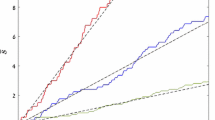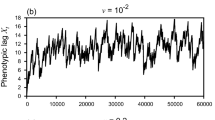Summary
A general method is given to obtain a stationary distribution in a “stochastic” one-dimensional dynamical system in which an environmental parameter specifying the dynamical system is a stationary Markov process with only two states. By applying this method, the exact stationary gene frequency distribution is obtained for a genic selection model in the environment fluctuating between two distinct states. Several limiting stationary distributions are obtained therefrom, and one of them is shown to coincide with a stationary solution of the diffusion equation heuristically derived by us for more general cases. Discussion is given on the relationship between the diffusion equations obtained by various authors starting from discrete, non-overlapping generation models.
Similar content being viewed by others
References
Arnold, L., Horsthemke, W., Lefever, R.: White and coloured external noise and transition phenomena in nonlinear systems. Z. Physik B 29, 367–373 (1978)
Avery, P. J.: The effect of random selection coefficients on populations of finite size — some particular models. Genet. Res. 29, 97–112 (1977)
Ayala, F. J., ed.: Molecular evolution. Sunderland, Massachusetts: Sinauer Associates, Inc. 1976
Capocelli, R. M., Ricciardi, L. M.: A diffusion model for population growth in a random environment. Theor. Pop. Biol. 5, 28–41 (1974)
Cook, R. D., Hartl, D. L.: Uncorrelated random environments and their effects on gene frequency. Evolution 28, 265–274 (1974)
Felsenstein, J.: The theoretical population genetics of variable selection and migration. Ann. Rev. Genet. 10, 253–280 (1976)
Gikhman, I. I.: Convergence to Markov processes. Ukrainian Math. J. 21, 263–270 (1969)
Gillespie, J. H.: The effects of stochastic environments on allele frequencies in natural populations. Theor. Pop. Biol. 3, 241–248 (1972)
Gillespie, J. H.: Natural selection with varying selection coefficients — a haploid model. Genet. Res. 21, 115–120 (1973a)
Gillespie, J. H.: Polymorphism in random environments. Theor. Pop. Biol. 4, 193–195 (1973b)
Gillespie, J. H., Guess, H. A.: The effects of environmental autocorrelation in a random environment. Amer. Nat. 112, 897–909 (1978)
Haken, H.: Synergetics, second enlarged edition. Berlin-Heidelberg-New York: Springer 1978
Harris, H.: Enzyme polymorphism in man. Proc. Roy. Soc. B 164, 298–310 (1966)
Hartl, D. L., Cook, R. D.: Autocorrelated random environments and their effects on gene frequency. Evolution 28, 275–280 (1974)
Hartl, D. L., Cook, R. D.: Stochastic selection and the maintenance of genetic variation. In: Population genetics and ecology (S. Karlin, E. Nevo, eds.), pp. 593–611. New York-San Francisco-London: Academic Press 1976
Hubby, J. L., Lewontin, R. C.: A molecular approach to the study of genic heterozygosity in natural populations. I. The number of alleles at different loci in Drosophila pseudoobscura. Genetics 54, 577–594 (1966)
Jensen, L.: Random selective advantages of genes and their probabilities of fixation. Genet. Res. 21, 215–219 (1973)
Karlin, S., Levikson, B.: Temporal fluctuations in selection intensities: Case of small population size. Theor. Pop. Biol. 6, 383–412 (1974)
Karlin, S., Lieberman, U.: Random temporal variation in selection intensities: Case of large population size. Theor. Pop. Biol. 6, 355–382 (1974)
Karlin, S., Lieberman, U.: Random temporal variation in selection intensities: One-locus two allele model. J. Math. Biol. 2, 1–17 (1975)
Kimura, M.: Processes leading to quasi-fixation of genes in natural populations with random fluctuations in selection intensities. Genetics 39, 280–295 (1954)
Kimura, M., Ohta, T.: Protein polymorphism as a phase of molecular evolution. Nature 229, 467–469 (1971a)
Kimura, M., Ohta, T.: Theoretical aspects of population genetics. Princeton, New Jersey: Princeton University Press 1971b
Kimura, M., Ohta, T.: On some principles governing molecular evolution. Proc. Nat. Acad. Sci. USA 71, 2848–2852 (1974)
Kitahara, K., Horsthemke, W., Lefever, R.: Coloured noise induced transitions: Exact results for external dichotomous Markovian noise. Phys. Lett. 70A, 377–380 (1979)
Kubo, R.: Stochastic Liouville equations. J. Math. Phys. 4, 174–183 (1963)
Kurtz, T. G.: Semigroups of conditioned shifts and approximation of Markov processes. Annals of Probability 3, 618–642 (1975)
Lax, M.: Classical noise IV: Langevin methods. Rev. Mod. Phys. 38, 541–566 (1966)
LeCam, L. M., Neyman, J., Scott, E. L., eds.: Darwinian, neo-Darwinian, and non-Darwinian evolution. In: Proc. sixth Berkeley symp. on math. statistics and probability, Vol. 5. Berkeley: University of California Press 1972
Lewontin, R. C.: The genetic basis of evolutionary change. New York-London: Columbia University Press 1974
Lewontin, R. C., Hubby, J. L.: A molecular approach to the study of genic heterozygosity in natural populations of Drosophila pseudoobscura. Genetics 54, 595–609 (1966)
Malliavin, H.: Stochastic calculus of variation and hypoelliptic operators. Proc. of Intern. Symp. SDE Kyoto 1976, pp. 195–263.
Matsuda, H., Gojobori, T.: Protein polymorphism and fluctuation of environments. Adv. Biophys. 12, 53–99 (1979)
Matsuda, H., Gojobori, T., Takahata, N.: Theoretical study on protein polymorphism and its bearing on the evolution of protein molecules. In: Evolution of protein molecules (H. Matsubara, T. Yamanaka, eds.), pp. 89–100. Tokyo: Japan Scientific Societies Press 1978
Maruyama, T., Kimura, M.: Theoretical study of genetic variability, assuming stepwise production of neutral and very slightly deleterious mutations. Proc. Nat. Acad. Sci. USA 75, 919–922 (1978)
Narain, P., Pollak, E.: On the fixation probability of a gene under random fluctuations in selection intensities in small populations. Genet. Res. 29, 113–121 (1977)
Nei, M.: Molecular population genetics and evolution. Amsterdam-Oxford: North Holland Publishing Company 1975
Nei, M.: Comments to stochastic selection and the maintenance of genetic variation by Hartl, D. L. and Cook, R. D. In: Population genetics and ecology (S. Karlin, E. Nevo, eds.), pp. 612–615. New York-San Francisco-London: Academic Press 1976
Nei, M., Yokoyama, S.: Effects of random fluctuation of selection intensity on genetic variability in a finite population. Japan. J. Genet. 51, 355–369 (1976)
Nelson, E.: The adjoint Markov process. Duke Math. J. 25, 671–690 (1958)
Nevo, E.: Genetic variation in natural populations: Patterns and theory. Theor. Pop. Biol. 13, 121–177 (1978)
Norman, M. F.: An ergodic theorem for evolution in a random environment. J. Appl. Prob. 12, 661–672 (1975)
Notohara, M., Ishii, K., Matsuda, H.: Use of orthogonal transformation in population genetics theory. J. Math. Biol. 6, 249–263 (1978)
Ohta, T.: Role of very slightly deleterious mutations in molecular evolution and polymorphism. Theor. Pop. Biol. 10, 254–275 (1976)
Papanicolaou, G. C., Varadhan, S. R. S.: A limit theorem with strong mixing in Banach space and two applications to stochastic differential equations. Comm. Pure and Appl. Math. 26, 497–524 (1973)
Papanicolaou, G. C.: Asymptotic analysis of transport processes. Bull. Amer. Math. Soc. 81, 330–392 (1975)
Powell, J. R.: Protein variation in natural populations of animals. In: Evolutionary biology, Vol. 8, pp. 79–119. New York: Plenum Press 1975
Sawyer, S. A., Slatkin, M.: Density independent fluctuations of population size. Theor. Pop. Biol., in press (1980)
Slatkin, M.: The dynamics of a population in a Markovian environment. Ecology 59, 249–256 (1978)
Takahata, N., Ishii, K., Matsuda, H.: Effect of temporal fluctuation of selection coefficient on gene frequency in a population. Proc. Nat. Acad. Sci. USA 72, 4541–4545 (1975)
Tuckwell, H. C.: The effects of random selection on gene frequency. Math. Biosciences 30, 113–128 (1976)
Wright, S.: Evolution and the genetics of populations. Chapt. 13. Chicago: The University of Chicago Press 1977
Author information
Authors and Affiliations
Rights and permissions
About this article
Cite this article
Matsuda, H., Ishii, K. Stationary gene frequency distribution in the environment fluctuating between two distinct states. J. Math. Biology 11, 119–141 (1981). https://doi.org/10.1007/BF00275437
Received:
Revised:
Issue Date:
DOI: https://doi.org/10.1007/BF00275437




